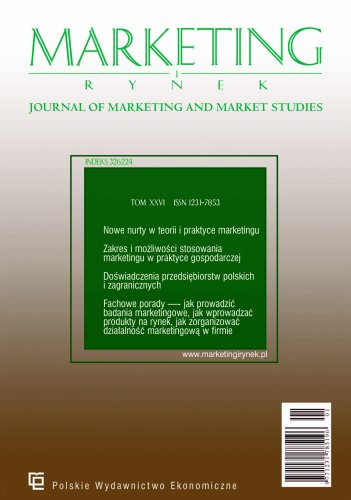Reklama natywna — determinanty skuteczności w kontekście założeń marketingu społecznego
Celem artykułu jest krytyczny przegląd definicji reklamy natywnej, zestawienie mierników jej skuteczności oraz ocena tej skuteczności w kontekście realizacji funkcji i zadań marketingu społecznego. Artykuł zawiera krytyczną analizę literatury przedmiotu. Wykazano, że dążenie do wzrostu skuteczności reklamy natywnej może się odbywać kosztem społecznie odpowiedzialnej promocji i komunikacji z klientem. Koncentracja wyłącznie na skuteczności reklamy natywnej, z pominięciem kwestii społecznych, kształtuje negatywne postawy odbiorców wobec tego narzędzia promocji oraz powoduje utratę zaufania wobec producenta i marki. Korzystanie z reklamy natywnej powinno zawierać czytelne oznakowanie komunikatu, tak aby odbiorcy jasno odróżniali przekaz komercyjny od innych treści publikowanych w medium. Realizując założenia społecznej odpowiedzialności, przedsiębiorstwo może podjąć edukację konsumentów w zakresie funkcjonowania reklamy natywnej.
Bibliografia
Bibliografia/References
Amazeen, M. A. i Wojdynski, B. W. (2018). Reducing Native Advertising Deception: Revisiting the Antecedents and Consequences of Persuasion Knowledge in Digital News Contexts. Mass Communication and Society, 22(2), 222–247.
Andreasen, A. R. (1994). Social Marketing: Its Definition and Domain. Journal of Public Policy & Marketing, 13(1), 108–114.
Backlinko (2019). Here's What We Learned About Page Speed. United States: Backlinko. https://backlinko.com/page-speed-stats (04.08.2021).
Benton, J. (2014). Like it or not, native advertising is squarely inside the big news tent. NiemanLab. https://www.niemanlab.org/2014/09/like-it-or-not-nativeadvertising-is-squarely-inside-the-big-news-tent/ (05.08.2021).
Czubała, A. (2013). Koncepcja i formy marketingu społecznego przedsiębiorstw. Zeszyty Naukowe Małopolskiej Wyższej Szkoły Ekonomicznej w Tarnowie, 22(1), 25–34.
Edwards, S., Li, H. i Lee, J. (2002). Forced Exposure and Psychological Reactance: Antecedents and Consequences of the Perceived Intrusiveness of Pop-Up Ads. Journal of Advertising, 31(3), 83–95.
Federal Trade Comission (2015). Native Advertising: A guide for businesses. United States: FTC. https://www.ftc.gov/tips-advice/business-center/guidance/native-advertising-guide-businesses (15.08.2021)
Google (2017). Find Out How You Stack Up to New Industry Benchmarks for Mobile Page Speed. United States: Google.
Google (2020). Native ads: Definition. Google Ads Help, https://support.google.com/google-ads/answer/7009059 (15.08.2021).
Griffin, R. W. (2013). Podstawy zarządzania organizacjami. Warszawa: Wydawnictwo Naukowe PWN.
Hudson, L. i Ozanne, J. (1988). Alternative ways of seeking knowledge in consumer research. Journal of Consumer Research, 14(4), 508–521.
Hwang, Y. i Jeong, S. (2019). Editorial Content In Native Advertising How Do Brand Placement and Content Quality Affect Native-Advertising Effectiveness? Journal of Advertising Research, 59(2), 208–218.
IAB Europe (2015). The Native Advertising Playbook. Bruksela: IAB Europe.
IAB Spain (2017). I Estudio Content & Native Advertising. Madryt: IAB Spain.
Kamiński, J. (2015). Jak bardzo społeczny jest marketing społeczny (cz. 1). Marketing i Rynek, 22(2), 2–9.
Kotler, P. (1994). Marketing. Analiza, planowanie, wdrażanie i kontrola. Warszawa: Gebethner i S-ka.
Kotler, P. i Zaltman, G. (1971). Social Marketing. An Approach to Planned Social Change. Journal of Marketing, 35(3), 3–12.
Kurzyk, B. (2014). Potencjał wykorzystania reklamy natywnej dla celów budowy siły marki. Marketing i Rynek, (11).
Lazauskas, J. (2014). Study: Sponsored content has a trust problem. United States: Contently, https://contently.com/2014/07/09/study-sponsored-content-has-a-trust-problem-2/ (14.08.2021).
Łodziana-Grabowska, J. (1996). Efektywność reklamy. Warszawa: PWE.
Maestro Espínola, L., Cordón Benito, D. i Abuín Vences, N. (2019). Integración de los mensajes comerciales y el contenido editorial en la prensa digital: publicidad nativa. Revista Pensar en la Publicidad, 13, 209–226.
Manic, M. (2015). The Rise of Native Advertising. Bulletin of the Transilvania University of Brașov, 8(57), 54–55.
Matteo, S. i Dal Zotto, C. (2015). Native advertising, or how to stretch editorial to sponsored content within a transmedia branding era. W: G. Siegert, K. Förster, S. Chan-Olmsted i M. Ots (red.), Handbook of media branding (169–185). Cham: Springer.
Nowak, D. (2017). Reklama natywna — najważniejsze aspekty prawne. Lookreatywni. https://lookreatywni.pl/baza-wiedzy/reklama-natywna-productplacement-rada-etyki-reklama/ (15.08.2021)
Sagan, A. (2013). Zmienne ukryte w badaniach marketingowych. Kraków: Wydawnictwo Uniwersytetu Ekonomicznego w Krakowie.
Schauster, E. E., Ferrucci, P. i Neill, M. S. (2016). Native Advertising is the New Journalism: How Deception Affects Social Responsibility. American Behavioral Scientist, 60(1), 1408–1424.
Sebastian, M. (2014). Native ad spending to jump despite marketer reservations. United States: Advertising Age. http://adage.com/article/digital/native-adspending-jumps-marketers-reservations/295956/ (14.08.2021).
Soontae, A., Kang, H. i Koo, S. (2018). Sponsorship Disclosures of Native Advertising: Clarity and Prominence. Journal of Consumer Affairs, 53(3), 998–1024.
Taboola (2021). Taboola Trends. United States: Taboola. https://www.trends.taboola.com (04.08.2021).
Taiminen, K., Luoma-aho, V. i Tolvanen, K. (2015). The Transparent Communicative Organization and New Hybrid Forms of Content. Public Relations Review, 41(5), 734–743.
Tutaj, K. i Van Reijmersdal, E. (2012). Effects of Online Advertising Format and Persuasion Knowledge on Audience Reactions. Journal of Marketing Communications, 18, 5–18.
Wang, P., Xiong, G. i Yang, J. (2019). Serial Position Effects on Native Advertising Effectiveness: Differential Results Across Publisher and Advertiser Metrics. Journal of Marketing, 83(2), 82–97.
Wilson, D. (2013). Native I advertising. Publishing Executive, 28(6).
Wojdynski, B. i Evans, N. (2020). The Covert Advertising Recognition and Effects (CARE) model: Processes of persuasion in native advertising and other masked formats. International Journal of Advertising, 39(1), 4–31.
Wu, M., Huang, Y., Li, R. i in. (2016). A Tale of Two Sources in Native Advertising: Examining the Effects of Source Credibility and Priming on Content, Organizations, and Media Evaluations. American Behavioral Scientist, 60(12), 1492–1509.
You, L. (2019). The Role Performance of Native Advertising in Legacy and Digital-Only News Media. Digital Journalism, 7(5), 592.

